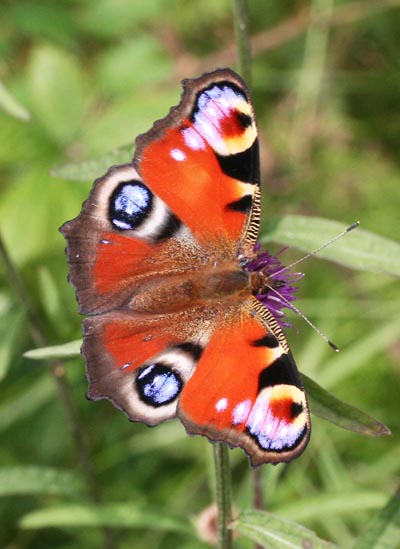I took around 200 shots of whatever looked good, and these are the highlights:
The Peacock is a butterfly that I see quite rarely. I'm not sure if there were a few of them on this woodland ride today, or if the same one was flying along overtaking me from time to time. The Peacock is a nettle feeder and the late summer generation is emerging now. These will overwinter as adults, emerging in spring as soon as it's warm enough:
 |
| Peacock butterfly |
Sicus ferrugineus is a conopid fly that can often be found crouched on knapweed flowerheads waiting for a bumblebee to land:
 |
| The Conopid fly Sicus ferrugineus |
Leucozona glaucia is one of the most colourful hoverflies that we have. The combination of blue abdomen, yellow scutellum and shiny brown thorax is quite striking.
 |
| The hoverfly Leucozona glaucia |
Sawfly larvae can be distinguished from moth and butterfly larvae by counting the number of prolegs. But I can generally pick them out quite quickly by their very round-shouldered appearance:
 |
| Sawfly larva on Ribwort Plantain |
 |
| Close-up of sawfly larva |
Caddis Flies are often mistaken for moths, especially when they come to light at night. The main distinguishing feature is the forward-facing antennae (although some of the longhorn moths also have this feature, in which case the Caddis Flies are recognised by their almost parallel antennae). This specimen is a female, identified by the greater number of jointed segments (5) in her mouthparts:
 |
| Caddisfly, member of the Limnephilidae family |
Caddis larvae are aquatic, living inside a case made from stones, shells, twigs or leaves, so the adults are usually seen close to water.
The Great Diving Beetle is also aquatic, and I found this one lying dead near a dried-out puddle:
 |
| Great Diving Beetle |
The Angelica is already running to seed, so I suppose I might have another two weeks of it left. It's certainly a major source of nectar for insects, and I found hundreds of hoverflies, dungflies, sawflies and other assorted insects nectaring on it today. This ichneumonid caught my eye, due to its very long ovipositor:
 |
| Ichneumonid on Angelica |

1 comment:
The butterfly is just gorgeous. Your pictures are always so crisp and clear. They are interesting besides. I'm glad you had a bit of time without rain.
Post a Comment